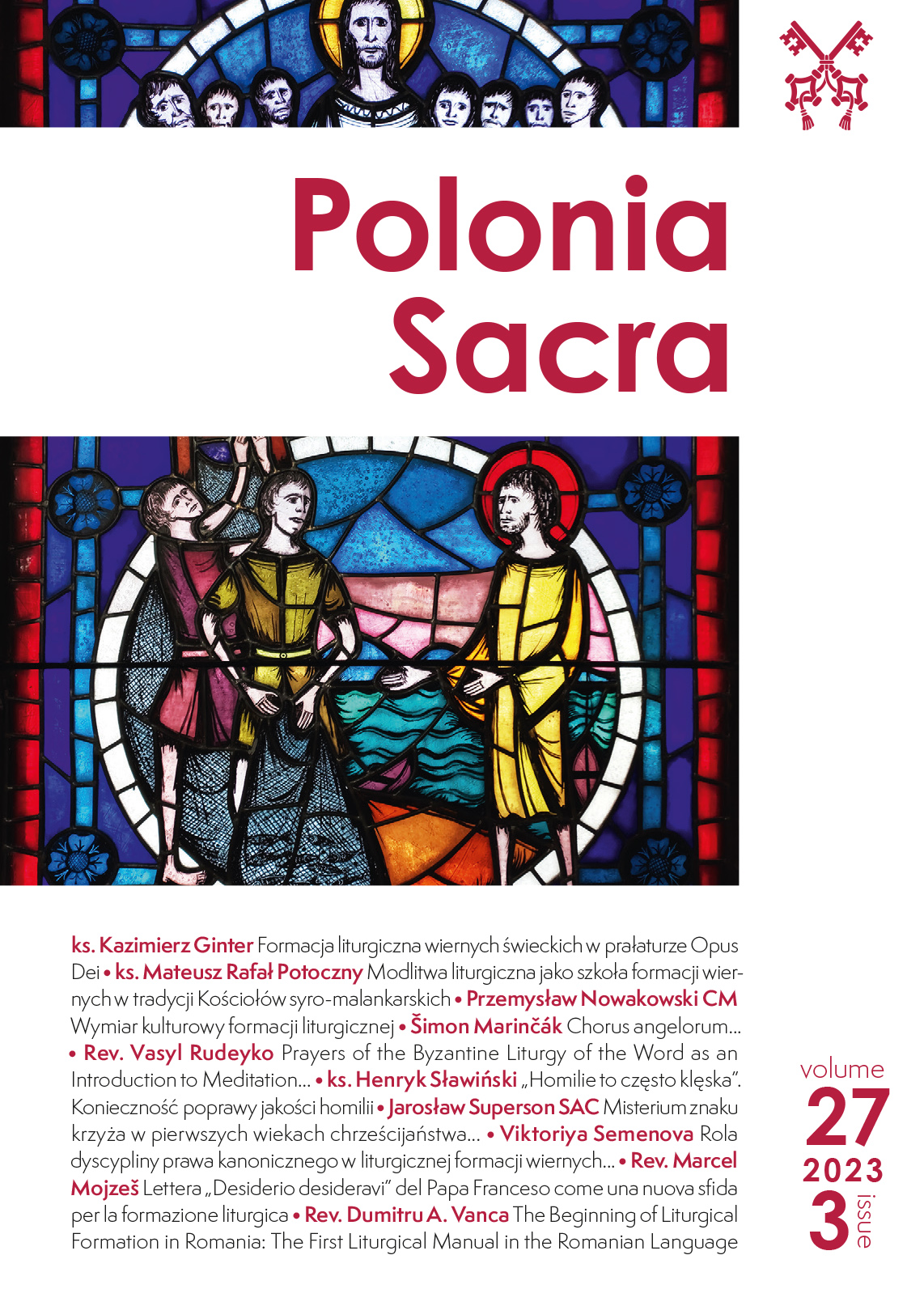Liturgical Prayer as a School of Formation for the Faithful in the Syro-Malnkara Church Tradition
DOI:
https://doi.org/10.15633/ps.27302Keywords:
liturgy, liturgical formation, Syro-Malankara Church, west-syrian tradition, IndiaAbstract
The Liturgy of the Church, being the first locus theologicus, is by its nature a space for the formation of the faithful. Both the liturgical texts and all other components of the celebrations should not be only an expression of worship, but also, they have to shape the faithful in both theological and moral dimensions. The article presents the formative role of the liturgy in the tradition of the Syro-Malankara Churches. In the following parts of the study, the reader will get acquainted with the historical outline of the syro-malankara tradition, with the general assumptions of the liturgical formation and with some examples of the formative role of the discussed liturgy.
References
Alexopoulos S., Johnson M. E., Introduction to Eastern Liturgies, Collegeville 2022.
Capizzi C., Lavenant R., Giacobbe (Giacomo) Baradeo o Baradai, w: Dizionario Enciclopedico dell’Oriente Cristiano, ed. by E. G. Farrugia, Roma 2000, s. 339–340.
Chediath G., The Malankara Catholic Church, Kottayam 2003.
Connolly R. H., The Liturgical Homilies of Narsai, Cambridge 1909.
Cyryl Jerozolimski, Katechezy przedchrzcielne i mistagogiczne, Kraków 2000.
George M. P., West Syriac Musical Tradition of the Beth Gazo’ in India, Kottayam 2012.
Jacobus Sarugensis, Homiliae Selectae, t. 1–3, oprac. P. Bedjan, Parisiis 1905–1908.
Jan Chryzostom, Katechezy chrzcielne, Kraków 2021.
John Paul II, Address to the Bishops of the Syro-Malankara Church of India on their „Ad Limina” Visit, Città del Vaticano, 13.05.2003, https://www.vatican.va/content/john-paul-ii/en/speeches/2003/may/documents/hf_jp-ii_spe_20030513_syro-malankara-church.html (31.12.2022).
Kanjiramukalil S., Ecclesial Identity of the Malankara Catholic Church, Kottayam 2002.
Koonammakkal T., The Church in the Churches: A Syriac Ecclesiology, Kuravilangad 2018.
Kopeć J. J., Formacja liturgiczna, czyli mistagogia w liturgii i przez liturgię, „Liturgia Sacra” 3–4 (1996) nr 2, s. 23–38.
Leksykon liturgii, oprac. B. Nadolski, Poznań 2006.
O’Collins G., Farrugia E. G., Leksykon pojęć teologicznych i kościelnych, Kraków 2002.
Pallath P., La Chiesa cattolica in India, Roma 2003.
Panicker G., St. Thomas in India According to Jacob of Sarug, „The Harp” 2 (1989), s. 59–64.
Petrazzini M. L., Formazione liturgica, w: Liturgia, a cura di D. Sartore, A. M. Triacca, C. Cibien, Cinisello Balsamo 2001, s. 828–845.
Podipara P. J., Hindu in Culture, Christian in Religion and Oriental in Worship, „Ostkirche Studien” 8 (1959), s. 82–104.
Potoczny M. R., Celebracje wielkiego tygodnia tradycji zachodniosyryjskiej w Kościele Syromalankarskim w Indiach, „Teologia i Człowiek” 41 (2018) nr 1, s. 139–157.
Potoczny M. R., Kościół dla wybranych? O specyfice indyjskich chrześcijan knānāya, „Teologia i Człowiek” 28 (2014) nr 4, s. 237–257.
Strothmann W., Jakob von Sarug. Drei Gedichte über den Apostel Thomas in Indien, Wiesbaden 1976.
Taft R., Ponad Wschodem i Zachodem. Problemy rozumienia liturgii, Kraków 2014.
Takso d-Qurobo, Kottayam 2014.
Vaidyan M., Liturgy and Spiritual Practices, https://mosc.in/the_church/liturgy/liturgy-and-spiritual-practices (29.12.2022).
Varghese B., Holy Week Celebrations in the West Syrian Church, w: Hebdomadae sanctae celebratio. Conspectus historicus comparativus, oprac. A. G. Kollamparampil, Roma 1997, s. 165–186.
Vysanethu P., Musicality makes the Malankara Liturgy Mystical, Kottayam 2004.
Downloads
Published
Issue
Section
License
Copyright (c) 2023 Mateusz Potoczny

This work is licensed under a Creative Commons Attribution 4.0 International License.
Authors who publish in this journal agree to the following terms:
- Authors retain the copyright and full publishing rights without restrictions and grant the journal right of first publication with the work simultaneously licensed under a Creative Commons Attribution 4.0 International License that allows others to share the work with an acknowledgement of the work's authorship and initial publication in this journal.
- Authors are able to enter into separate, additional contractual arrangements for the non-exclusive distribution of the journal's published version of the work (e.g., post it to an institutional repository or publish it in a book), with an acknowledgement of its initial publication in this journal.
- Authors are permitted and encouraged to post their work online (e.g., in institutional repositories or on their website) prior to and during the submission process, as this can lead to productive exchanges, as well as earlier and greater citation of published work (See The Effect of Open Access).

